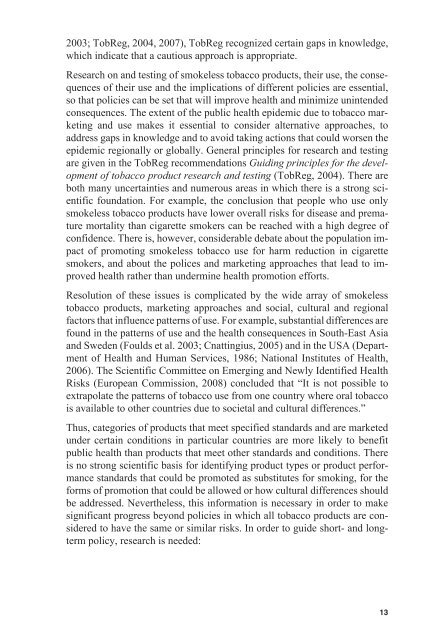The Scientific Basis of Tobacco Product Regulation - World Health ...
The Scientific Basis of Tobacco Product Regulation - World Health ...
The Scientific Basis of Tobacco Product Regulation - World Health ...
Create successful ePaper yourself
Turn your PDF publications into a flip-book with our unique Google optimized e-Paper software.
2003; TobReg, 2004, 2007), TobReg recognized certain gaps in knowledge,<br />
which indicate that a cautious approach is appropriate.<br />
Research on and testing <strong>of</strong> smokeless tobacco products, their use, the consequences<br />
<strong>of</strong> their use and the implications <strong>of</strong> different policies are essential,<br />
so that policies can be set that will improve health and minimize unintended<br />
consequences. <strong>The</strong> extent <strong>of</strong> the public health epidemic due to tobacco marketing<br />
and use makes it essential to consider alternative approaches, to<br />
address gaps in knowledge and to avoid taking actions that could worsen the<br />
epidemic regionally or globally. General principles for research and testing<br />
are given in the TobReg recommendations Guiding principles for the development<br />
<strong>of</strong> tobacco product research and testing (TobReg, 2004). <strong>The</strong>re are<br />
both many uncertainties and numerous areas in which there is a strong scientific<br />
foundation. For example, the conclusion that people who use only<br />
smokeless tobacco products have lower overall risks for disease and premature<br />
mortality than cigarette smokers can be reached with a high degree <strong>of</strong><br />
confidence. <strong>The</strong>re is, however, considerable debate about the population impact<br />
<strong>of</strong> promoting smokeless tobacco use for harm reduction in cigarette<br />
smokers, and about the polices and marketing approaches that lead to improved<br />
health rather than undermine health promotion efforts.<br />
Resolution <strong>of</strong> these issues is complicated by the wide array <strong>of</strong> smokeless<br />
tobacco products, marketing approaches and social, cultural and regional<br />
factors that influence patterns <strong>of</strong> use. For example, substantial differences are<br />
found in the patterns <strong>of</strong> use and the health consequences in South-East Asia<br />
and Sweden (Foulds et al. 2003; Cnattingius, 2005) and in the USA (Department<br />
<strong>of</strong> <strong>Health</strong> and Human Services, 1986; National Institutes <strong>of</strong> <strong>Health</strong>,<br />
2006). <strong>The</strong> <strong>Scientific</strong> Committee on Emerging and Newly Identified <strong>Health</strong><br />
Risks (European Commission, 2008) concluded that “It is not possible to<br />
extrapolate the patterns <strong>of</strong> tobacco use from one country where oral tobacco<br />
is available to other countries due to societal and cultural differences.”<br />
Thus, categories <strong>of</strong> products that meet specified standards and are marketed<br />
under certain conditions in particular countries are more likely to benefit<br />
public health than products that meet other standards and conditions. <strong>The</strong>re<br />
is no strong scientific basis for identifying product types or product performance<br />
standards that could be promoted as substitutes for smoking, for the<br />
forms <strong>of</strong> promotion that could be allowed or how cultural differences should<br />
be addressed. Nevertheless, this information is necessary in order to make<br />
significant progress beyond policies in which all tobacco products are considered<br />
to have the same or similar risks. In order to guide short- and longterm<br />
policy, research is needed:<br />
13

















